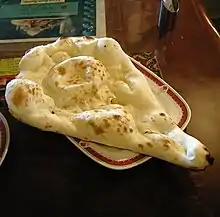.jpg.webp) Sannas | |
| Place of origin | India |
|---|---|
| Region or state | Konkan division, Goa, Damaon and Canara |
| Similar dishes | White sugar sponge cake |
A sanna (Konkani: सान्नां) is a spongy, steamed, and savoury unfilled dumpling originally made of red rice, black lentil and coconut in the Konkan region, by the western coast of the Indian subcontinent. They originated in Goa and Damaon, Mangalore, Bombay and Bassein (Vasai), and are especially popular among Goans, both the Goan Hindus and Goan Christians, and also among the Konkani migrants outside Konkan in Karachi, Sindh, Gujarat, Karnataka and Kerala. They are also loved by the people of the Konkan division, such as the Kuparis of the Bombay East Indian community.
Hindus normally use urad dal, coconut water and coconut milk for fermentation.[1] Catholic sannas consist of two types: Those made from the toddy of coconut flowers, and those sannas made using the sap-toddy of the coconut palm.[2] Though both of them require the same varieties of rice, sannas are commonly made with coconut for fermentation, unlike idlis that are commonly made by adding yeast.[3][4][5] They are made on special days such as Ganesh Chaturthi, Sonsar Padvo/Yugadi and Makar Sankranti,[1] Catholics generally prepare them for church feasts, christenings and weddings. Sometimes a sweet version is made with jaggery, known as godachi sanna (Konkani: गोडाची सान्नां, goddachee sanna).[6]
Mangalorean Catholic cuisine on special days is incomplete without sannas. They are a much-loved delicacy and are served with bafat, a spicy pork curry prepared with a medley of powdered spices. Sannas are also served alongside chicken or mutton curries, and also with beef before the beef ban in India. They can be eaten for breakfast with coconut chutney or saambhar, or with coconut milk sweetened with jaggery and flavoured with cardamom.
In the present day, the unavailability or ban of toddy in certain places and the difficult and lengthy process of extracting fresh coconut milk have made the dish an occasional delicacy, prepared during Konkani celebrations only. Sometimes the dish is completely substituted by idlis, made of white rice and yeast-based batter.
See also
Citations
- 1 2 Gazetteer of the Union Territory Goa, Daman and Diu: district gazetteer, Volume 1. Goa, Daman and Diu (India). Gazetteer Dept. 1979. p. 258.
- ↑ Kuper, Jessica (1997). The anthropologists' cookbook. Kegan Paul International. p. 208. ISBN 978-0-7103-0531-2.
- ↑ "Sannas Recipe, Goan Steamed Rice Bread".
- ↑ "Sanna | Sannas - Steamed Rice Cakes + Video". 11 June 2011.
- ↑ "Sanna Recipe: How to Make Sanna Recipe | Homemade Sanna Recipe".
- ↑ Gomes, Olivinho (1987). Village Goa: a study of Goan social structure and change. S. Chand. pp. 249–250.


